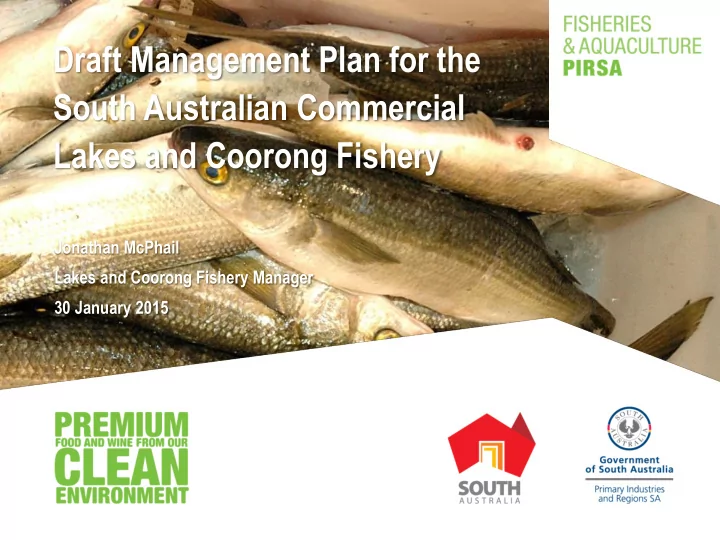

Draft Management Plan for the South Australian Commercial Lakes and Coorong Fishery Jonathan McPhail Lakes and Coorong Fishery Manager 30 January 2015
Draft Management Plan for the South Australian Commercial Lakes and Coorong Fishery • Management Plan is to establish a framework to protect, manage, use and develop aquatic resources consistent with ecological sustainable development principles • The draft management plan has been prepared by the South Australia Government in conjunction with the Southern Fisherman’s Association and Goolwa Pipi Harvesters Association • Prepared in accordance with provisions of the Fisheries Management Act 2007 • Sections 40 - 50
Lakes and Coorong Fishing Area
Lakes and Coorong Fishery Overview Lakes and Ngarrindjeri People Coorong Commercial Fishery Source: Garry Hera ‐ Singh Thukeri Big fish and lots of fish. Photo source: Garry Hera ‐ Singh Pondi
Lakes and Coorong Fishery Overview
Process to date • Minister requested preparation of management plan • Ecological sustainable development risk assessment • Steering Committee formed to develop management plan • Pipi harvest strategy developed • Finfish harvest strategy developed • Public consultation
Management Plan • Provides “plan for management” of the fishery — Description of the fishery — Management goals — Ecosystem impacts (Ecological Risk Assessment) — Co-management — Allocation of access among sectors — Harvest strategies — Regulatory arrangements — Stock assessment and research — Compliance and monitoring
Management Plan • Provides “plan for management” of the fishery — Description of the fishery — Management goals — Ecosystem impacts (Ecological Risk Assessment) — Co-management — Allocation of access among sectors — Harvest strategies — Regulatory arrangements — Stock assessment and research — Compliance and monitoring
Goal and Objectives (pg. 72) 1. Ensure the Lakes and Coorong Fishery resources are harvested within sustainable limits 2. Optimum utilisation and equitable distribution of the Lakes and Coorong Fishery resources 3. Minimise impacts on the ecosystem 4. Cost effective and participative management of the fishery
Ecological Risk Assessment (pg. 67) Over 90 potential risks assessed: — Over half considered Negligible or Low — Just over a quarter of risks considered Moderate to High — 4 Extreme ENJOY LIFE IN OUR MARINE PARKS
Allocation • Primary and secondary species allocated: – Importance to fishery (commercial & recreational) – Production (total catch) – Commercial & recreational value – Level of exploitation – Variability in catches and reliability of catch estimates Primary Species Secondary Species Tertiary Species Pipi Black Bream Australian Herring Golden Perch Greenback Flounder Snapper* Mulloway* Yabby Mullet spp.* Flathead European Carp etc Bony Bream
Allocation – Primary and Secondary species Primary Species Species Commercial Recreational Aboriginal Total traditional Mullet Marine 54.2% 44.8% 1% 100% spp. L&C (Inland) 98.9% 0.55% 0.55% 100% (catch) Marine 19.9% 79.1% 1% 100% Mulloway (catch) L&C (Inland) 71.4% 27.6% 1% 100% Golden Perch SAMDB 71.6% 27.4% 1% 100% (catch) Pipi (area) 73 % 26% 1% 100% Secondary Species Species Commercial Recreational Aboriginal Total traditional Black Bream (catch) 50.6% 48.4% 1% 100% Greenback Flounder 88.7% 10.3% 1% 100% (catch)
Pipi Harvest Strategy (pg.83) Traffic Light system Limit reference points • Relative biomass of legal-sized Pipi is <4 kg/4.5 m² Target reference point • Mean relative biomass of legal-sized Pipi is ≥ 10 kg/4.5 m² Trigger reference point • Pre-recruits represent at least 30% of the overall length frequency
Finfish Harvest Strategy (pg.83) Proposed primary performance indicators Reference Points Sector Primary performance indicator Target Trigger Limit Freshwater - LMGN Water level (m - Australian Height Datum) 0.6 -0.7 -1.2 Estuarine - LMGN Available habitat (%) for Mulloway 60 17 10 Estuarine - SMGN Available habitat (%) for Yelloweye Mullet 55 31 10 Proposed decision rules for the Freshwater – large mesh gill-net sector If mean annual water level (m AHD) in the Lakes is : TACE setting Above +0.6 m 190,000 net-days Between +0.17 m and +0.6 m 173,000 net-days Between -0.26 m and 0.16 m 143,650 net-days Between -0.7 m and -0.27 m 115,000 net-days Between -0.9 m and -0.71 m 55,400 net-days Between -1.2 m and -0.91 m 38,000 net-days Below -1.2 m AHD Closure of sector
Process from here • Copy of draft management plan – Please leave your name and contact details on the sheet provided or; – Contact: Lucy Stark, Executive Assistant, Fisheries Council on (08) 8226 8103 – www.fisheriescouncil.sa.gov.au • Written submissions must be received by Wednesday 4 February 2015 • Consideration of comments and amendments by Minister
Questions and Discussion
Recommend
More recommend